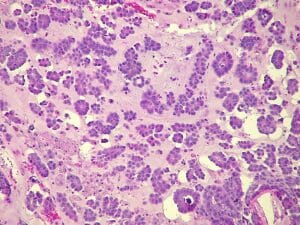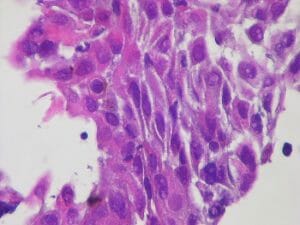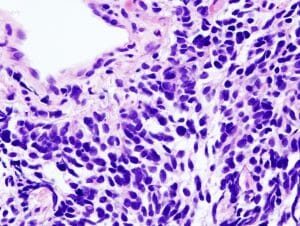Carcinoma Definition
Carcinoma is a term used to describe cancer derived from epithelial cells that line various tissues throughout the body. In addition, malignant tumors that have an unknown primary origin, but share histological characteristics with epithelial cells (e.g., stratification, pseudostratification, cytokeratin production, mucin, etc.) are also classified as carcinomas. Depending on the location, carcinomas can be surgically removed, or treated with conventional radiation or chemotherapy.
Types of Carcinoma
Carcinomas are classified based on the histological features that they exhibit. The following terms are used to describe the most common types of carcinomas.
Adenocarcinoma
Adenocarcinomas are carcinomas which are derived from glandular epithelial cells or exhibit glandular characteristics. Thus, the cells often exhibit structural and molecular features consistent with glandular tissue (see below). Adenocarcinomas are some of the most common types of cancer, of which the pancreas, breast, and cervix are the most frequently affected organs. This is largely attributed to the fact that breast, colorectal, and genital tissues are highly glandular.

Squamous Cell Carcinoma
Squamous cell carcinoma refers to carcinomas that are derived from the skin and exhibit features specific to squamous cell differentiation (see below). Some examples of these features include squamous pearls and keratinization. Squamous cell carcinomas are most frequently caused by prolonged exposure to direct sunlight without sun protection. Moreover, squamous cell carcinoma is more common in individuals with lighter colored skin. In addition, squamous cell carcinoma is associated with a higher risk of metastases and the symptoms are often highly variable or asymptomatic. Approximately 90% of all head and neck cancers are classified as squamous cell carcinoma.

Basal Cell Carcinoma
Basal cell carcinomas originate in the folliculo-sebaceous-apocrine region of the basal layer of the skin. As such, this type of carcinoma is one of the most common forms of skin cancer following exposure to direct sunlight. There are three specific types of basal cell carcinoma, which include superficial, nodular, and infiltrative basal cell carcinoma. This type of carcinoma accounts for approximately 70% of all non-melanoma related skin cancers.
Anaplastic Carcinoma
Anaplastic carcinomas are carcinomas that lack specific histological or morphological hallmarks of differentiated cells. In these types of cells, the nucleus to cytoplasm ratio is altered such that the nucleus is highly enlarged and hyperchromatic, indicative of an elevated proliferative potential. Moreover, the enlarged nuclei are often irregularly shaped and exhibit a complete loss in cellular polarity.
Large Cell Carcinoma
Large cell carcinomas are characterized by the absence of the histological hallmarks of other carcinomas and exhibit a large cytoplasm and a polygonal morphology. The most common etiology of large cell carcinoma is a history of cigarette smoking.
Small Cell Carcinoma
Small cell carcinoma is exhibited by extremely small, round cells with little cytoplasm (see below). These cells are also polygonal or spindle-shaped. In addition, small cell carcinomas are extremely malignant, with rapid doubling times and a high tendency for metastases (approximately 70% of cases). The most common locations of small cell carcinoma include the lung and cervix. This type of carcinoma is highly associated with cigarette smokers, as small cell carcinoma is rarely observed in non-smokers.

Adenosquamous Carcinoma
Adenosquamous carcinomas are tumors which exhibit characteristics of both squamous cell carcinoma, each comprising a minimum of 10% of the total tumor volume. This type of cancer is most frequently observed in the lung, but is relatively uncommon, comprising between 1% and 5% of all lung cancers. In addition, there is a high linkage between adenosquamous carcinomas and a history of smoking.
Quiz
1. The histological analysis of a lung biopsy from a suspicious lesion of a smoker reveals cells smaller than lymphocytes, exhibiting minimal cytoplasm. This type of carcinoma is best described as:
A. Squamous cell carcinoma
B. Adenocarcinoma
C. Adenosquamous carcinoma
D. Small cell carcinoma
2. The histological analysis of a skin biopsy revealed malignant cells exhibiting keratinization. This type of carcinoma is most likely:
A. Squamous cell carcinoma
B. Adenocarcinoma
C. Adenosquamous carcinoma
D. Small cell carcinoma
References
- Antonelli A and La Motta C. (2017). Novel therapeutic clues in thyroid carcinomas: The role of targeting cancer stem cells. Med Res Rev. doi: 10.1002/med.21448.
- Filippiadis et al. (2017). Metastatic bone disease from breast cancer: a review of minimally invasive techniques for diagnosis and treatment. Eur J Orthop Surg Traumatol. doi: 10.1007/s00590-017-1986-9.
- Stucky et al. (2017). Single-cell genomic analysis of head and neck squamous cell carcinoma. Oncotarget. doi: 10.18632/oncotarget.18021.
